Co-Loaded Curcumin and Methotrexate Nanocapsules Enhance Cytotoxicity against Non-Small-Cell Lung Cancer Cells
Abstract
1. Introduction
2. Results and Discussion
2.1. Preparation and Characterization of Polymeric Nanocapsules (NCs) Containing Curcumin (CUR) and/or Methotrexate (MTX)
2.1.1. Determination of Mean Diameter, Polydispersity Index, and Zeta Potential
2.1.2. Encapsulation Efficiency
2.1.3. Field Emission Scanning Electron Microscopy (FESEM)
2.1.4. X-ray Diffraction (XRD)
2.1.5. Fourier-Transform Infrared Spectroscopy (FTIR)
2.2. In Vitro Drug Release Study
2.3. In Vitro Cell Culture-Based Assays
2.3.1. Cell Viability by MTT and SRB Tests
2.3.2. Combination Index
2.3.3. Cell Death Pattern through Acridine Orange/Ethidium Bromide (AO/EB) Test
3. Materials and Methods
3.1. Materials
3.2. Preparation of Polymeric Nanocapsules (NCs) Containing Curcumin (CUR) and/or Methotrexate (MTX)
3.3. Characterization of Polymeric Nanocapsules (NCs) Containing Curcumin (CUR) and/or Methotrexate (MTX)
3.3.1. Determination of Mean Diameter, Polydispersity Index, and Zeta Potential of NCs
3.3.2. Encapsulation Efficiency
3.3.3. Field Emission Scanning Electron Microscopy (FESEM)
3.3.4. X-ray Diffraction (XRD)
3.3.5. Fourier-Transform Infrared Spectroscopy (FTIR)
3.4. In Vitro Drug Release Study
3.5. In Vitro Cell Culture-Based Assays
3.5.1. Cell Culture
3.5.2. Cell Treatment
3.5.3. Cell Viability by Methylthiazolyldiphenyl-tetrazolium Bromide (MTT) Test
3.5.4. Combination Index
3.5.5. Cell Viability by Sulphorhodamine B (SRB) Test
3.5.6. Cell Death Pattern through Acridine Orange/Ethidium Bromide (AO/EB) Test
3.6. Statistical Analysis
4. Conclusions
Author Contributions
Funding
Acknowledgments
Conflicts of Interest
References
- Waheed, A.; Gupta, A.; Patel, P. Targeted Drug Delivery Systems for Lung Cancer. PharmaTutor 2015, 3, 38–42. [Google Scholar]
- Chen, L.; Nan, A.; Zhang, N.; Jia, Y.; Li, X.; Ling, Y.; Dai, J.; Zhang, S.; Yang, Q.; Yi, Y.; et al. Circular RNA 100146 functions as an oncogene through direct binding to miR361-3p and miR-615-5p in non-small cell lung cancer. Mol. Cancer 2019, 18, 1–8. [Google Scholar] [CrossRef]
- Huber, P.C.; Maruiama, C.H.; Almeida, W.P. Glicoproteína-p, resistência a múltiplas drogas (mdr) e relação estrutura-atividade de moduladores. Quim. Nova 2010, 33, 2148–2154. [Google Scholar] [CrossRef]
- Niu, S.; Williams, G.R.; Wu, J.J.; Zhang, X.; Zheng, H.; Li, S.; Zhu, L.M. A novel chitosan-based nanomedicine for multi-drug resistant breast cancer therapy. Chem. Eng. J. 2019, 369, 134–149. [Google Scholar] [CrossRef]
- Ke, X.J.; Cheng, Y.F.; Yu, N.; Di, Q. Effects of carbamazepine on the P-gp and CYP3A expression correlated with PXR or NF-κB activity in the bEnd.3 cells. Neurosci. Lett. 2019, 690, 48–55. [Google Scholar] [CrossRef] [PubMed]
- Albano, J.M.R.; Ribeiro, L.N.M.; Couto, V.M.; Messias, M.B.; Silva, G.H.R.; Breitkreitz, M.C.; Paula, E.; Pickholz, M. Rational design of polymer-lipid nanoparticles for docetaxel delivery. Colloids Surf. B Biointerfaces 2019, 175, 56–64. [Google Scholar] [CrossRef] [PubMed]
- Chearwae, W.; Anuchapreeda, S.; Nandigama, K.; Ambudkar, S.V.; Limtrakul, P. Biochemical mechanism of modulation of human P-glycoprotein (ABCB1) by curcumin I, II and III purified from Turmeric powder. Biochem. Pharmacol. 2004, 68, 2043–2052. [Google Scholar] [CrossRef]
- Santiago, V.S.; Silva, G.P.M.; Ricardo, D.D.; Lima, M.E.F. Curcumina, o Pó Dourado do Açafrão-Da-Terra: Introspecções Sobre Química e Atividades Biológicas. Quím. Nova 2015, 38, 538–552. [Google Scholar]
- Mishra, H.; Kesharwani, R.K.; Singh, D.B.; Tripathi, S.; Dubey, S.K.; Misra, K. Computational simulation of inhibitory effects of curcumin, retinoic acid and their conjugates on GSK-3 beta. New Model Anal. Health Inform. Bioinform 2019, 8, 1–3. [Google Scholar] [CrossRef]
- Sharma, R.A.; Gescher, A.J.; Steaward, W.P. Curcumin: The story so far. Eur. J. Cancer 2005, 41, 1955–1968. [Google Scholar] [CrossRef]
- Huaasin, Z.; Thu, H.E.; Ng, S.F.; Khan, S.; Katas, H. Nanoencapsulation, an efficient and promising approach to maximize wound healing efficacy of curcumin: A review of new trends and state-of-the-art. Colloids Surf. B Biointerfaces 2017, 150, 223–241. [Google Scholar] [CrossRef] [PubMed]
- Teng, Y.N.; Hsieh, Y.W.; Hung, C.C.; Lin, H.Y. Demethoxycurcumin Modulates Human P-Glycoprotein Function via Uncompetitive Inhibition of ATPase Hydrolysis Activity. J. Agric. Food Chem. 2015, 63, 847–855. [Google Scholar] [CrossRef] [PubMed]
- Khalil, N.M.; Nascimento, T.C.F.; Casa, D.M.; Dalmolin, L.F.; Mattos, A.C.; Hoss, I.; Romano, M.A.; Mainardes, R.M. Pharmacokinetics of curcumin-loaded PLGA and PLGA-PEG blend nanoparticles after oral administration in rats. Colloids Surf. B Biointerfaces 2013, 101, 353–360. [Google Scholar] [CrossRef] [PubMed]
- Brandt, J.V.; Piazza, R.D.; Santos, C.C.; Chacón, J.V.; Amantéa, B.E.; Pinto, G.C.; Magnani, M.; Piva, H.L.; Tedesco, A.C.; Primo, F.L.; et al. Synthesis and colloidal characterization of folic acid-modified PEG-b-PCL Micelles for methotrexate delivery. Colloids Surf. B Biointerfaces 2019, 177, 228–234. [Google Scholar] [CrossRef] [PubMed]
- Katiyar, S.S.; Kushwah, V.; Dora, C.P.; Jain, S. Lipid and TPGS based novel core-shell type nanocapsular sustained release system of methotrexate for intravenous application. Colloids Surf. B Biointerfaces 2019, 174, 501–510. [Google Scholar] [CrossRef]
- Rubino, F.M.J. Separation methods for methotrexate, its structural analogues and metabolites. Chromatogr B 2001, 764, 217–254. [Google Scholar] [CrossRef]
- Prasad, R.; Koul, V.; Anand, S.; Khar, R.K. Effect of DC/mDC iontophoresis and terpenes on transdermal permeation of methotrexate: In vitro study. Int. J. Pharm. 2007, 333, 70–78. [Google Scholar] [CrossRef]
- Choi, C.H. ABC transporters as multidrug resistance mechanisms and the development of chemosensitizers for their reversal. Cancer Cell Int. 2005, 5, 1–13. [Google Scholar] [CrossRef][Green Version]
- Zhu, Y.; Meng, Q.; Wang, C.; Liu, Q.; Huo, X.; Zhang, A.; Sun, P.; Sun, H.; Li, H.; Liu, K. Methotrexate-bestatin interaction: Involvement of P-glycoprotein and organic anion transporters in rats. Int. J. Pharm. 2014, 465, 368–377. [Google Scholar] [CrossRef]
- Dey, S.; Sherly, M.C.D.; Rekha, M.R.; Sreenivasan, K. Alginate stabilized gold nanoparticle as multidrug Carrier: Evaluation of cellular interactions and hemolytic potential. Carbohydr. Polym. 2016, 136, 71–80. [Google Scholar] [CrossRef]
- Curcio, M.; Mauro, L.; Naimo, G.D.; Amantea, D.; Cirillo, G.; Tavano, L.; Casaburi, I.; Nicoletta, F.P.; Alvarez-Lorenzo, C.; Iemma, F. Facile synthesis of pH-responsive polymersomes based on lipidized PEG for intracellular co-delivery of curcumin and methotrexate. Colloids Surf. B Biointerfaces. 2018, 1, 568–576. [Google Scholar] [CrossRef]
- Vakilinezhad, M.A.; Amini, A.; Dara, T.; Alipour, S. Methotrexate and Curcumin co-encapsulated PLGA nanoparticles as a potential breast cancer therapeutic system: In vitro and In vivo evaluation. Colloids Surf. B Biointerfaces. 2019, 184, 1–10. [Google Scholar] [CrossRef]
- Curcio, M.; Cirillo, G.; Tucci, P.; Farfalla, A.; Bevacqua, E.; Vittorio, O.; Iemma, F.; Nicoletta, F.P. Dextran-Curcumin Nanoparticles as a Methotrexate Delivery Vehicle: A Step Forward in Breast Cancer Combination Therapy. Pharmaceuticals 2020, 2, 2. [Google Scholar] [CrossRef]
- Gomes, M.L.S.; Nascimento, N.S.; Borsato, D.M.; Pretes, A.P.; Nadal, J.M.; Novatski, A.; Gomes, R.Z.; Fernandes, D.; Farago, P.V.; Zanin, S.M.W. Long-lasting anti-platelet activity of cilostazol from poly(ε-caprolactone) poly(ethylene glycol) blend nanocapsules. Mater Sci Eng C. 2019, 94, 694–702. [Google Scholar]
- Chassot, J.M.; Ribas, D.; Silveira, E.F.; Grünspan, L.D.; Pires, C.C.; Farago, P.V.; Braganhol, E.; Tasso, L.; Cruz, L. Beclomethasone Dipropionate-Loaded Polymeric Nanocapsules: Development, In Vitro Cytotoxicity, and In Vivo Evaluation of Acute Lung Injury. J. Nanosci. Nanotechnol. 2014, 14, 1–10. [Google Scholar] [CrossRef]
- Ferreira, L.M.; Cervi, V.F.; Sari, M.H.M.; Barbieria, A.V.; Ramos, A.P.; Copetti, P.M.; Brum, G.F.; Nascimento, K.; Nadal, J.M.; Farago, P.V.; et al. Diphenyl diselenide loaded poly(ε-caprolactone) nanocapsules with selective antimelanoma activity: Development and cytotoxic evaluation. Mater. Sci. Eng. C. 2018, 91, 1–9. [Google Scholar] [CrossRef]
- Aditya, N.; Ravi, P.R.; Avula, U.S.R.; Vats, R. Poly (e-caprolactone) nanocapsules for oral delivery of raloxifene: Process optimization by hybrid design approach, in vitro and in vivo evaluation. J Microencapsul. 2014, 31, 508–518. [Google Scholar] [CrossRef]
- Schaffazick, S.R.; Guterres, S.S. Caracterização e Estabilidade Físico-Química de Sistemas Poliméricos Nanoparticulados para Administração de Fármacos. Quím. Nova 2003, 26, 726–737. [Google Scholar] [CrossRef]
- Avadi, M.R.; Sadeghi, A.M.M.; Mohammadpour, N.; Abedin, S.; Atyabi, F.; Dinarvand, R.; Tehrani, M.R. Preparation and characterization of insulin nanoparticles using chitosan and Arabic gum with ionic gelation method. Nanomedicine 2010, 6, 58–63. [Google Scholar] [CrossRef]
- Neves, A.R.; Lúcio, M.; Martins, S.; Lima, J.; Reis, S. Novel resveratrol nanodelivery systems based on lipid nanoparticles to enhance its oral bioavailability. Int. J. Nanomed. 2013, 8, 177–187. [Google Scholar]
- O’Neil, M.J.; Heckelman, P.E.; Dobbelaar, P.H.; Roman, K.J.; Kenney, C.M.; Karaffa, L.S. The Merck Index: An Encyclopedia of Chemicals, Drugs, and Biologicals; Maryadele, J.O.N., Patricia, E.H., Cherie, B.K., Kristin, J.R., Eds.; Royal Society of Chemistry: Cambridge, UK, 2013; p. 474. [Google Scholar]
- Michael, D.L.; Richard, J.L., Sr.; Robert, A.L. Hawley’s Condensed Chemical Dictionary, 13rd ed.; John Wiley & Sons: New York, NY, USA, 1997; p. 722. [Google Scholar]
- Mora-Huertas, C.E.; Fessi, H.; Elaissari, A. Polymer-based nanocapsules for drug delivery. Int. J. Pharm. 2010, 385, 113–142. [Google Scholar] [CrossRef]
- Zhang, Q.; Polyakov, N.E.; Chistyachenko, Y.S.; Khvostov, M.V.; Frolova, T.S.; Tolstikova, T.G.; Dushkin, A.V.; Su, W. Preparation of curcumin self-micelle solid dispersion with enhanced bioavailability and cytotoxic activity by mechanochemistry. Drug Deliv. 2018, 25, 198–209. [Google Scholar] [CrossRef]
- Teng, Z.; Luo, Y.; Wang, Q. Nanoparticles Synthesized from Soy Protein: Preparation, Characterization, and Application for Nutraceutical Encapsulation. J. Agric. Food Chem. 2012, 60, 2712–2720. [Google Scholar] [CrossRef]
- Oliveira, A.R.; Molina, E.F.; Mesquita, P.C.; Fonseca, J.L.C.; Rossanezi, G.; Pedrosa, M.F.F.; Oliveira, A.G.; Júnior, A.A.S. Structural and thermal properties of spray-dried methotrexate-loaded biodegradable microparticles. J. Therm. Anal. Calorim. 2013, 112, 555–565. [Google Scholar] [CrossRef]
- Mendes, J.B.E.; Riekes, M.K.; Oliveira, V.M.; Michel, M.D.; Stulzer, H.K.; Khalil, N.M.; Zawadzki, S.F.; Mainardes, R.M.; Farago, P.V. PHBV/PCL Microparticles for Controlled Release of Resveratrol: Physicochemical Characterization, Antioxidant Potential, and Effect on Hemolysis of Human Erythrocytes. Sci. World J. 2012, 2012, 1–13. [Google Scholar] [CrossRef]
- Song, Z.; Zhu, W.; Liu, N.; Yang, F.; Feng, R. Linolenic acid-modified PEG-PCL micelles for curcumin delivery. Int. J. Pharm. 2014, 471, 312–321. [Google Scholar] [CrossRef]
- Hu, L.; Kong, D.; Hu, Q.; Gao, N.; Pang, S. Evaluation of High-Performance Curcumin Nanocrystals for Pulmonary Drug Delivery Both In Vitro and In Vivo. Nanoscale Res. Lett. 2015, 10, 1–9. [Google Scholar] [CrossRef]
- Bich, V.T.; Thuy, N.T.; Binh, N.T.; Huong, N.T.M.; Yen, P.N.D.; Luong, T.T. Structural and Spectral Properties of Curcumin and Metal-Curcumin Complex Derived from Turmeric (Curcuma longa). In Physics and Engineering of New Materials, Heidelberg, Germany, 15 January 2009, D.T.; Pucci, A., Wandelt, K., Eds.; Springer: Berlin, Germany, 2009; pp. 271–278. [Google Scholar]
- Ajmal, M.; Yunus, U.; Matin, A.; Haq, N.U. Synthesis, characterization and in vitro evaluation of methotrexate conjugated fluorescent carbon nanoparticles as drug delivery system for human lung cancer targeting. J. Photoch. Photobiol. B 2015, 153, 111–120. [Google Scholar] [CrossRef]
- Yurgel, V.; Collares, T.; Seixas, F. Developments in the use of nanocapsules in oncology. Braz. J. Med. Biol. Res. 2013, 46, 486–501. [Google Scholar] [CrossRef]
- Mirza, M.A.; Rahman, M.A.; Talegaonkar, S.; Iqbal, Z. In vitro/in vivo performance of different complexes of itraconazole used in the treatment of vaginal candidiasis. Braz. J. Pharm. Sci. 2012, 48, 759–772. [Google Scholar] [CrossRef][Green Version]
- Dhanasekaran, S.; Biswal, B.K.; Sumantran, V.N.; Verma, R.S. Augmented sensitivity to methotrexate by curcumin induced overexpression of folate receptor in KG-1 cells. Biochimie 2013, 95, 1567–1573. [Google Scholar] [CrossRef]
- Wang, P.; Zhang, L.; Peng, H.; Li, Y.; Xiong, J.; Xu, Z. The formulation and delivery of curcumin with lipid nanoparticles for the treatment of non-small cell lung cancer both in vitro and in vivo. Mater. Sci. Eng. C. 2013, 33, 4802–4808. [Google Scholar]
- Yallapu, M.M.; Gupta, B.K.; Jaggi, M.; Chauhan, S.C.J. Fabrication of curcumin encapsulated PLGA nanoparticles for improved therapeutic effects in metastatic cancer cells. Colloid Interface Sci. 2010, 351, 19–29. [Google Scholar] [CrossRef]
- Houghton, P.; Fang, R.; Techatanawat, I.; Steventon, G.; Hylands, P.J.; Lee, C.C. The sulphorhodamine (SRB) assay and other approaches to testing plant extracts and derived compounds for activities related to reputed anticancer activity. Methods 2007, 42, 377–387. [Google Scholar] [CrossRef]
- Nadal, J.M.; Gomes, M.L.S.; Borsato, D.M.; Almeida, M.A.; Barboza, F.M.; Zawadzki, S.F.; Kanunfre, C.C.; Farago, P.V.; Zanin, S.M.W. Spray-dried Eudragit®® L100 microparticles containing ferulic acid: Formulation, in vitro cytoprotection and in vivo anti-platelet effect. Mater. Sci. Eng. C 2016, 64, 318–328. [Google Scholar]
- Hamilton, K.O.; Backstrom, G.; Yazdanian, M.A.; Audus, K.L. P-Glycoprotein Eflux Pump Expression and Activity in Calu-3 Cells. J. Pharm. Sci. 2001, 90, 647–658. [Google Scholar] [CrossRef]
- Srivalli, K.M.R.; Lakshmi, P.K. Overview of P-glycoprotein inhibitors: A rational outlook. Braz. J. Pharm. Sci. 2012, 48, 353–367. [Google Scholar] [CrossRef]
- Coleman, M.L.; Sahai, E.A.; Yeo, M.; Bosch, M.; Dewar, A.; Olson, M.F. Membrane blebbing during apoptosis results from caspase-mediated activation of ROCK I. Nat. Cell. Biol. 2001, 3, 339–345. [Google Scholar] [CrossRef]
- Wang, F.; Dai, W.; Wang, Y.; Shen, M.; Chen, K.; Cheng, P.; Zhang, Y.; Wang, C.; Li, J.; Zheng, Y.; et al. The Synergistic In Vitro and In Vivo Antitumor Effect of Combination Therapy with Salinomycin and 5-Fluorouracil against Hepatocellular Carcinoma. PLoS ONE 2014, 9, 1–10. [Google Scholar] [CrossRef]
- Kroemer, G.; Dallaporta, B.; Resche-Rigon, M. The mitochondrial death/life regulator in apoptosis and necrosis. Annu. Ver. Physiol. 1998, 60, 619–642. [Google Scholar] [CrossRef]
- Zakeri, Z.; Lockshin, R.A. Cell death during development. J. Immunol. Methods 2002, 265, 3–20. [Google Scholar] [CrossRef]
- Fessi, H.; Puisieux, F.; Devissaguet, J.P.; Ammoury, N.; Benita, S. Nanocapsule formation by interfacial polymer deposition following solvent displacement. Int. J. Pharm. 1989, 55, R1–R4. [Google Scholar] [CrossRef]
- Mosmann, T. Rapid colorimetric assay for cellular growth and survival: Application to proliferation and cytotoxicity assays. J. Immunol. Methods 1983, 65, 55–63. [Google Scholar] [CrossRef]
- D’oll-Boscardin, P.M.; Sartoratto, A.; Maia, B.H.L.N.S.; de Paula, J.P.; Nakashima, T.; Farago, P.V.; Kanunfre, C.C. In vitro cytotoxic potential of essential oils of Eucalyptus benthamii and its related terpenes on tumor cell lines. Evid. Based Complement Altern. Med. 2012, 2012, 1–8. [Google Scholar] [CrossRef]
- Kifer, D.; Jakši’c, D.; Klari´c, M.Š. Assessing the Effect of Mycotoxin Combinations: Which Mathematical Model Is (the Most) Appropriate? Toxins 2020, 12, 153. [Google Scholar] [CrossRef]
- Papazisis, K.T.; Geromichalos, G.D.; Dimitriadis, K.A.; Kortsaris, A.H. Optimization of the sulforhodamine B colorimetric assay. J. Immunol. Methods 1997, 208, 151–158. [Google Scholar] [CrossRef]
- Ribble, D.; Goldstein, N.B.; Norris, D.A.; Shellman, Y.G. A simple technique for quantifying apoptosis in 96-well plates. BMC Biotechnol. 2005, 5, 1–12. [Google Scholar] [CrossRef]
Sample Availability: Samples of the compounds curcumin and methotrexate, and the polymeric nanocapsules NCUR-2, NMTX-1, and NCUR/MTX-2 are available from the authors. |
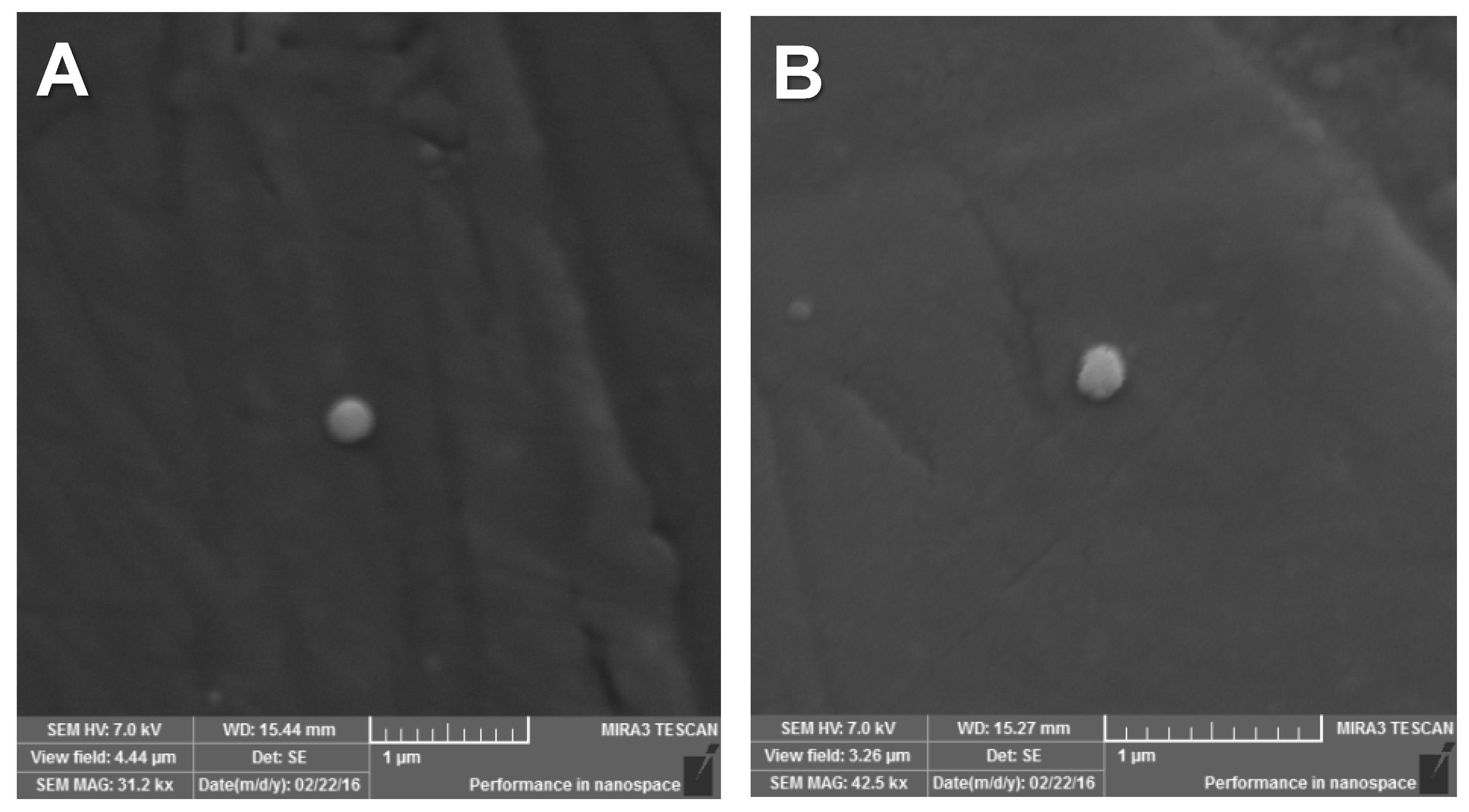
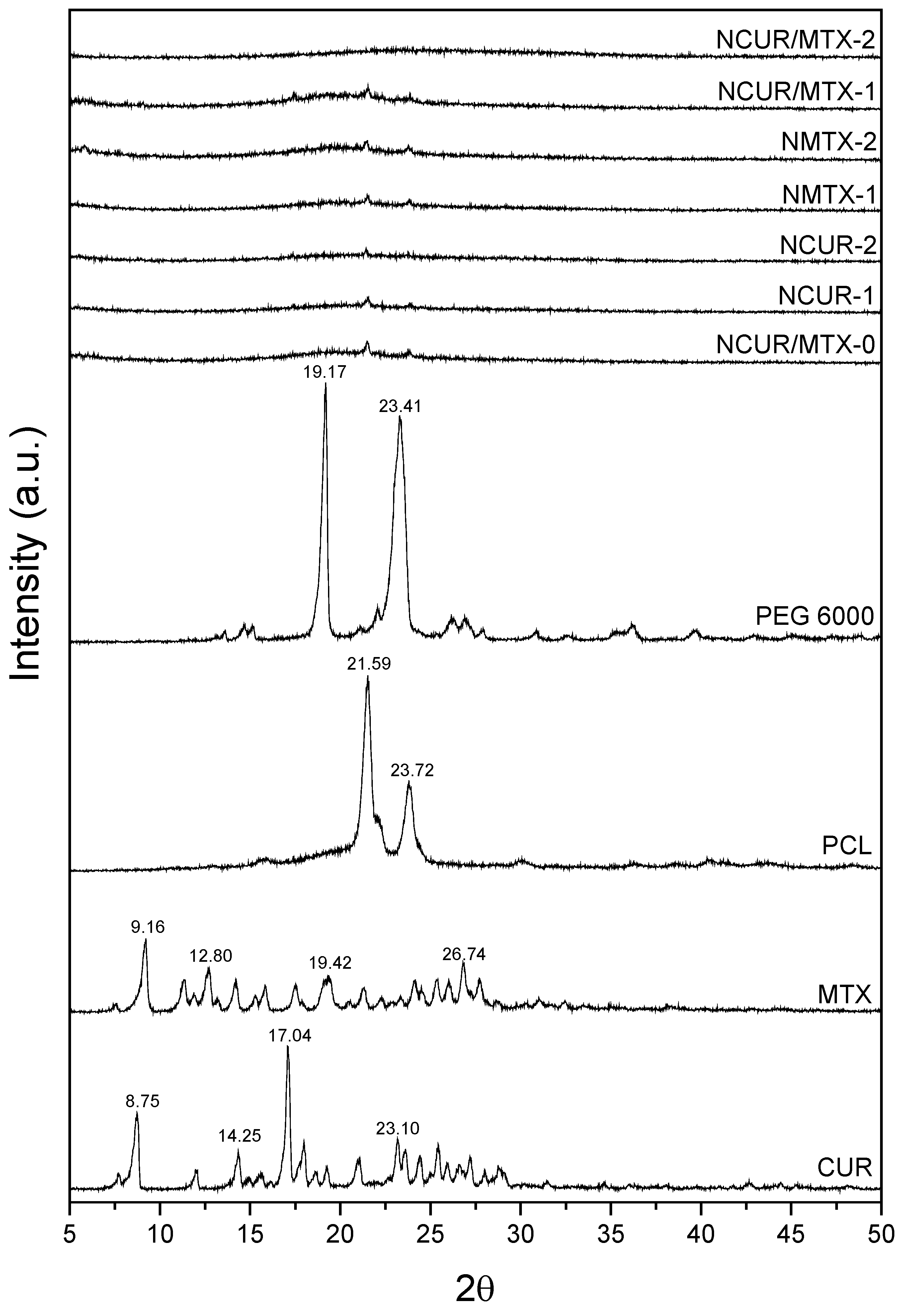
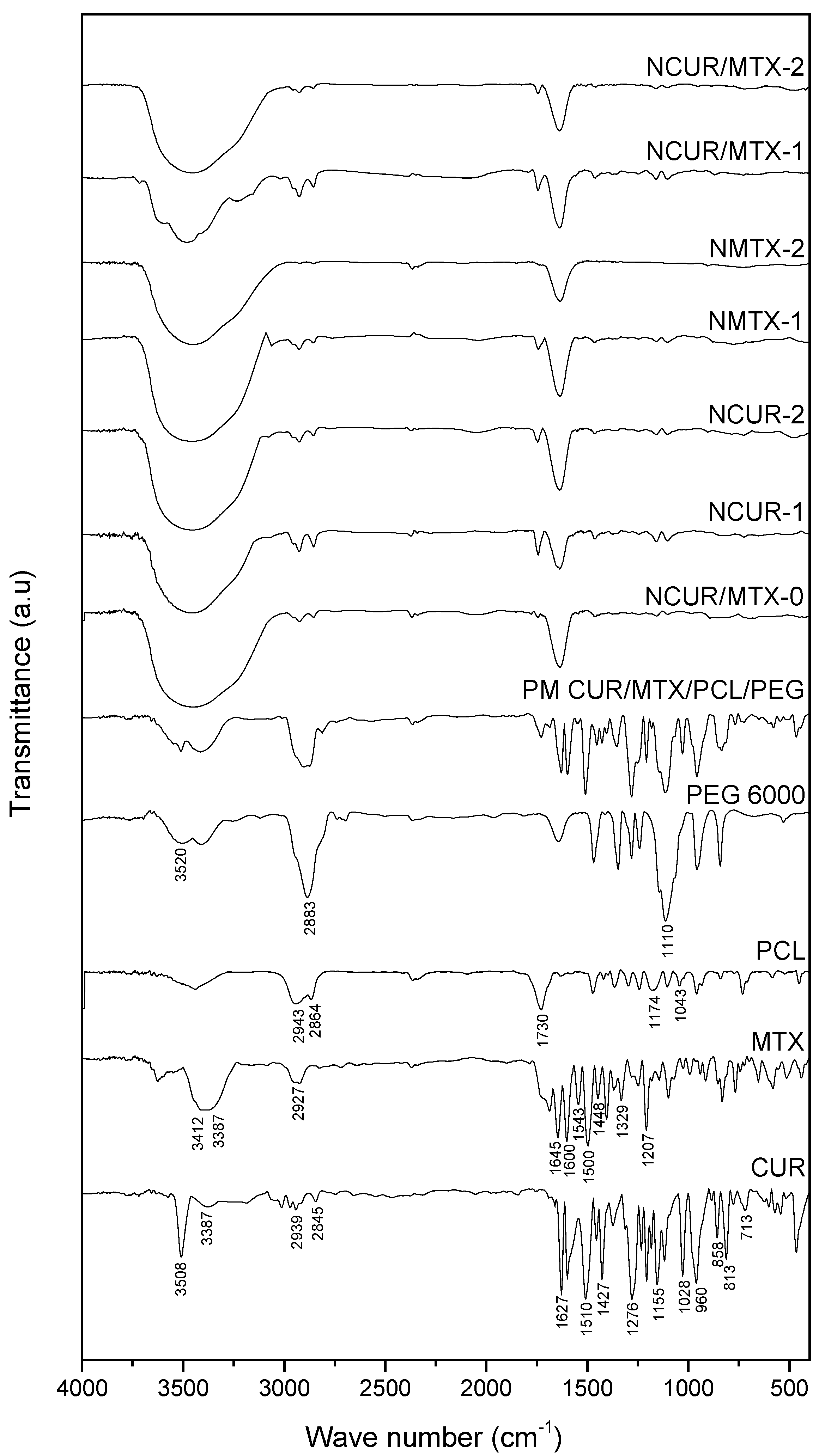
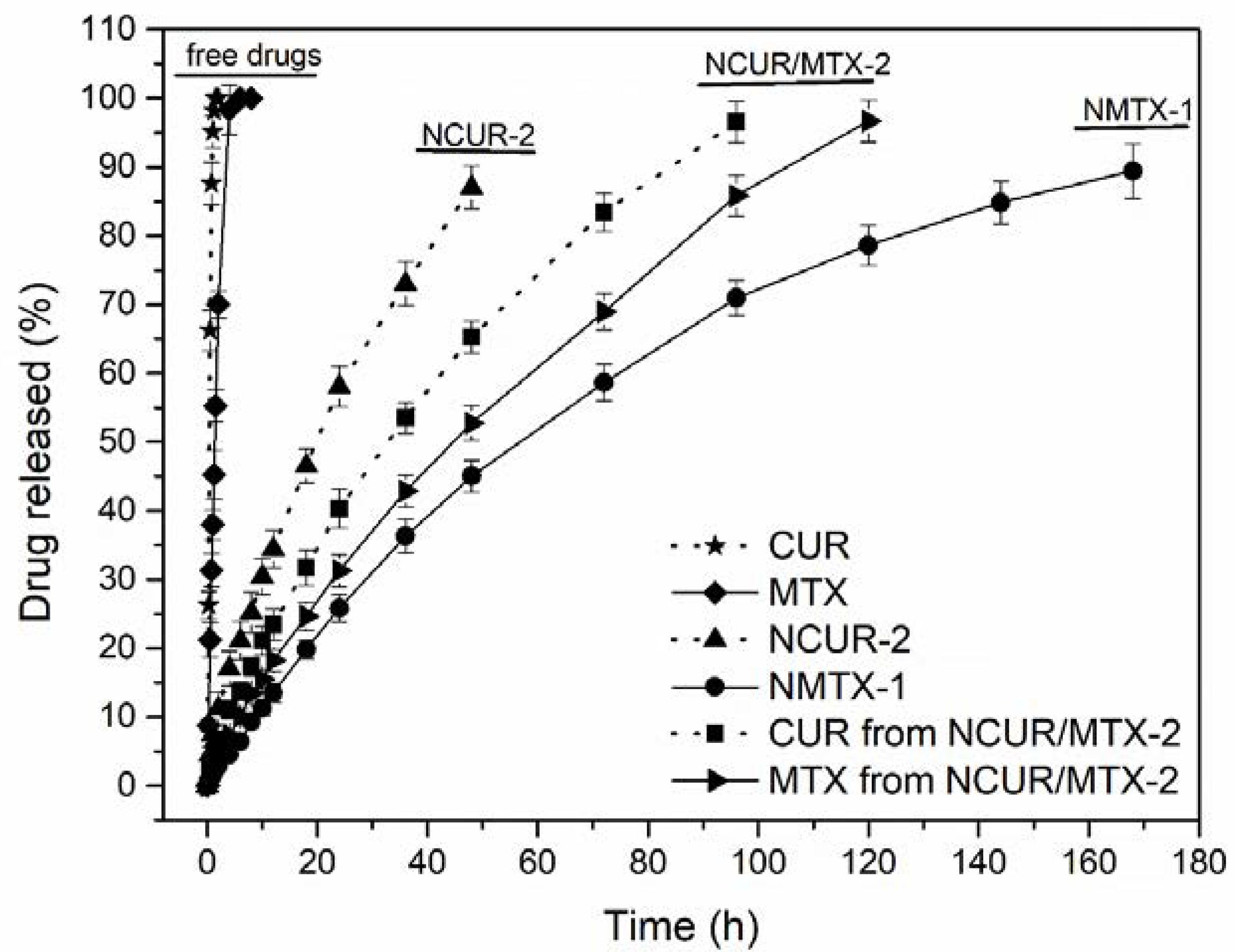
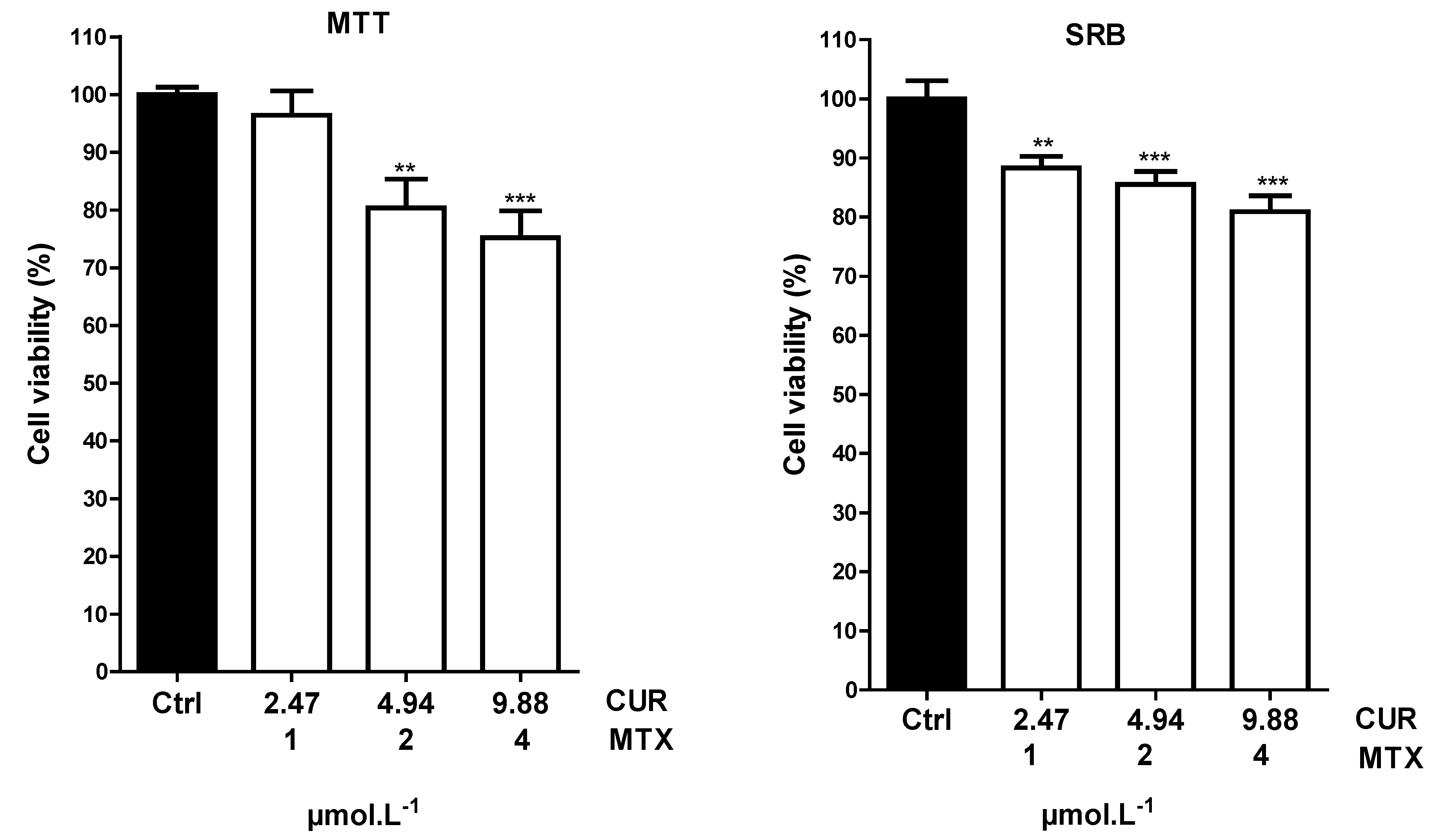
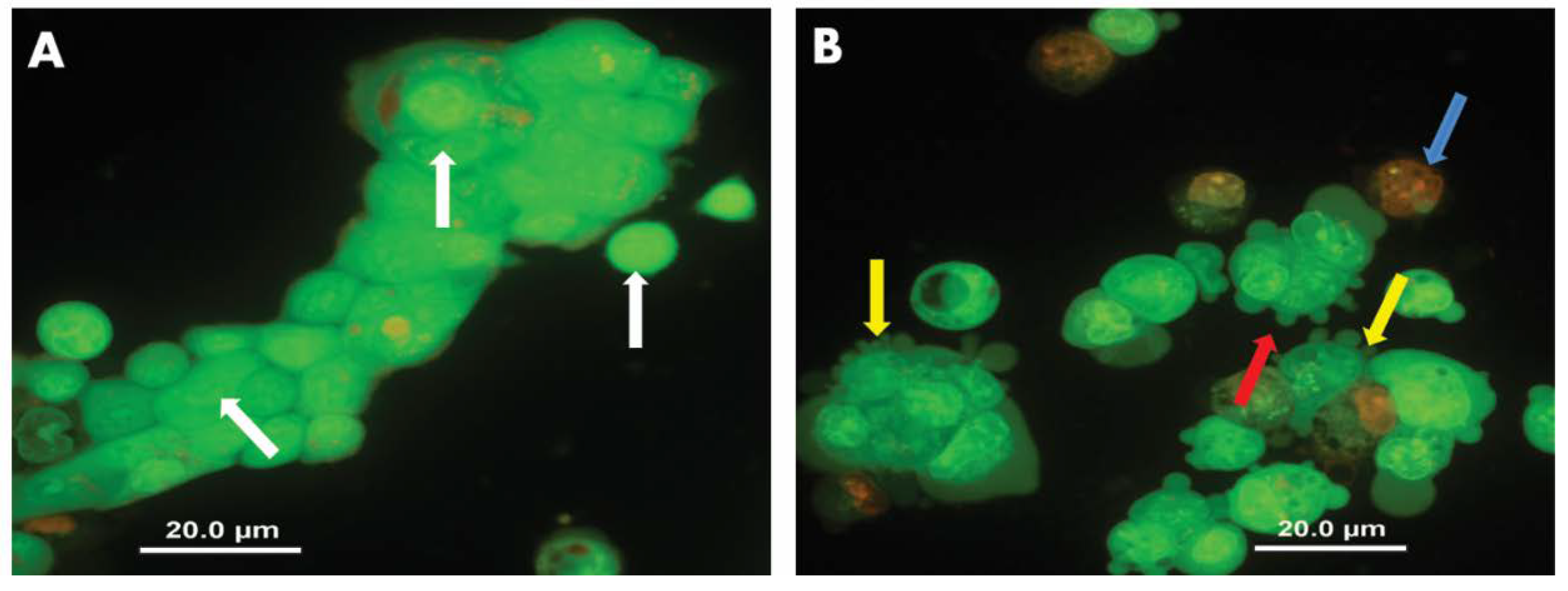
| Formulation | Mean Particle Size * (nm) | PDI * | Zeta Potential * (mV) | EE * (%) |
|---|---|---|---|---|
| NCUR/MTX-0 | 313.30 ± 48.20 | 0.351 ± 0.15 | −39.83 ± 2.46 | - |
| NCUR-1 | 307.26 ± 29.40 | 0.323 ± 0.07 | −38.80 ± 7.45 | 99.4 ± 0.51 |
| NCUR-2 | 315.96 ± 10.30 | 0.351 ± 0.02 | −41.20 ± 7.20 | 98.7 ± 0.66 |
| NMTX-1 | 287.83 ± 28.00 | 0.290 ± 0.11 | −40.60 ± 5.80 | 88.9 ± 0.47 |
| NMTX-2 | 298.60 ± 25.00 | 0.292 ± 0.01 | −38.96 ± 1.60 | 83.3 ± 0.42 |
| NCUR/MTX-1 | 312.03 ± 23.60 | 0.344 ± 0.05 | −39.43 ± 6.26 | 99.1 ± 0.63 (CUR) 84.4 ± 0.57 (MTX) |
| NCUR/MTX-2 | 325.16 ± 28.90 | 0.351 ± 0.03 | −33.40 ± 3.29 | 99.3 ± 0.54 (CUR) 82.4 ± 0.44 (MTX) |
| Sample | Final Concentration (µmol·L−1) | Cell Viability (%) | |
|---|---|---|---|
| MTT | SRB | ||
| NCUR-2 | 0 | 100.00 ± 1.60 | 99.98 ± 1.75 |
| 25 | 91.48 ± 3.36 | 88.30 ± 4.01 | |
| 50 | 87.74 ± 5.62 | 60.68 ± 6.10 *** | |
| 100 | 49.91 ± 5.73 *** | 33.87 ± 3.07 *** | |
| 200 | 4.16 ± 0.67 *** | 3.32 ± 0.47 *** | |
| NMTX-1 | 0 | 100.00 ± 0.95 | 99.79 ± 1.22 |
| 0.5 | 100.37 ± 1.96 | 96.10 ± 2.57 | |
| 1 | 100.60 ± 2.15 | 93.01 ± 4.48 | |
| 2 | 99.53 ± 1.67 | 90.85 ± 3.80 | |
| 4 | 93.90 ± 4.60 | 90.78 ± 4.67 | |
| Formulation | Composition | ||||||||
|---|---|---|---|---|---|---|---|---|---|
| CUR (g) | MTX (g) | PEG (g) | PCL (g) | Span 80 (g) | MCT (g) | Acetone (mL) | Tween 80 (g) | Water (mL) | |
| NCUR/MTX-0 | - | - | 0.020 | 0.080 | 0.077 | 0.300 | 27 | 0.077 | 53 |
| NCUR-1 | 0.010 | - | 0.020 | 0.080 | 0.077 | 0.300 | 27 | 0.077 | 53 |
| NCUR-2 | 0.030 | - | 0.020 | 0.080 | 0.077 | 0.300 | 27 | 0.077 | 53 |
| NMTX-1 | - | 0.001 | 0.020 | 0.080 | 0.077 | 0.300 | 27 | 0.077 | 53 |
| NMTX-2 | - | 0.003 | 0.020 | 0.080 | 0.077 | 0.300 | 27 | 0.077 | 53 |
| NCUR/MTX-1 | 0.030 | 0.001 | 0.020 | 0.080 | 0.077 | 0.300 | 27 | 0.077 | 53 |
| NCUR/MTX-2 | 0.005 | 0.003 | 0.020 | 0.080 | 0.077 | 0.300 | 27 | 0.077 | 53 |
© 2020 by the authors. Licensee MDPI, Basel, Switzerland. This article is an open access article distributed under the terms and conditions of the Creative Commons Attribution (CC BY) license (http://creativecommons.org/licenses/by/4.0/).
Share and Cite
Rudnik, L.A.C.; Farago, P.V.; Manfron Budel, J.; Lyra, A.; Barboza, F.M.; Klein, T.; Kanunfre, C.C.; Nadal, J.M.; Bandéca, M.C.; Raman, V.; et al. Co-Loaded Curcumin and Methotrexate Nanocapsules Enhance Cytotoxicity against Non-Small-Cell Lung Cancer Cells. Molecules 2020, 25, 1913. https://doi.org/10.3390/molecules25081913
Rudnik LAC, Farago PV, Manfron Budel J, Lyra A, Barboza FM, Klein T, Kanunfre CC, Nadal JM, Bandéca MC, Raman V, et al. Co-Loaded Curcumin and Methotrexate Nanocapsules Enhance Cytotoxicity against Non-Small-Cell Lung Cancer Cells. Molecules. 2020; 25(8):1913. https://doi.org/10.3390/molecules25081913
Chicago/Turabian StyleRudnik, Loanda Aparecida Cabral, Paulo Vitor Farago, Jane Manfron Budel, Amanda Lyra, Fernanda Malaquias Barboza, Traudi Klein, Carla Cristine Kanunfre, Jessica Mendes Nadal, Matheus Coelho Bandéca, Vijayasankar Raman, and et al. 2020. "Co-Loaded Curcumin and Methotrexate Nanocapsules Enhance Cytotoxicity against Non-Small-Cell Lung Cancer Cells" Molecules 25, no. 8: 1913. https://doi.org/10.3390/molecules25081913
APA StyleRudnik, L. A. C., Farago, P. V., Manfron Budel, J., Lyra, A., Barboza, F. M., Klein, T., Kanunfre, C. C., Nadal, J. M., Bandéca, M. C., Raman, V., Novatski, A., Loguércio, A. D., & Zanin, S. M. W. (2020). Co-Loaded Curcumin and Methotrexate Nanocapsules Enhance Cytotoxicity against Non-Small-Cell Lung Cancer Cells. Molecules, 25(8), 1913. https://doi.org/10.3390/molecules25081913








